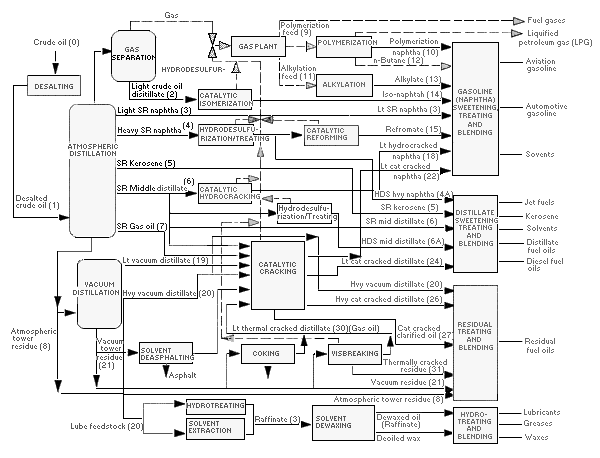The petroleum industry began with the successful drilling of the first commercial oil well in 1859, and the opening of the first refinery two years later to process the crude into kerosene. The evolution of petroleum refining from simple distillation to today’s sophisticated processes has created a need for safety and risk based management procedures. Refining is the processing of one complex mixture of hydrocarbons into a number of other complex mixtures of hydrocarbons. The safe and orderly processing of crude oil into flammable gases and liquids at high temperatures and pressures using vessels, equipment, and piping subjected to stress and corrosion requires considerable knowledge, control, and expertise.
Petroleum refining begins with the distillation, or fractionation, of crude oils into separate hydrocarbon groups. The resultant products are directly related to the characteristics of the crude processed. Most distillation products are further converted into more usable products by changing the size and structure of the hydrocarbon molecules through cracking, reforming, and other conversion processes. These converted products are then subjected to various treatment and separation processes such as extraction, hydrotreating, and sweetening to remove undesirable constituents and improve product quality. Integrated refineries incorporate fractionation, conversion, treatment, and blending operations and may also include petrochemical processing.
Refinery Process Flow Chart
Petroleum refining processes and operations can be separated into five basic areas:
- Fractionation (distillation) is the separation of crude oil in atmospheric and vacuum distillation towers into groups of hydrocarbon compounds of differing boiling-point ranges called “fractions” or “cuts.”
- Conversion Processes change the size and/or structure of hydrocarbon molecules. These processes include:
- Decomposition (dividing) by thermal and catalytic cracking;
- Unification (combining) through alkylation and polymerization; and
- Alteration (rearranging) with isomerization and catalytic reforming.
- Treatment Processes are intended to prepare hydrocarbon streams for additional processing and to prepare finished products. Treatment may include the removal or separation of aromatics and naphthenes as well as impurities and undesirable contaminants. Treatment may involve chemical or physical separation such as dissolving, absorption, or precipitation using a variety and combination of processes including desalting, drying, hydrodesulfurizing, solvent refining, sweetening, solvent extraction, and solvent dewaxing.
- Formulating and Blending is the process of mixing and combining hydrocarbon fractions, additives, and other components to produce finished products with specific performance properties.
- Other Refining Operations include: light-ends recovery, sour-water stripping, solid waste and wastewater treatment, process-water treatment and cooling, storage and handling, product movement, hydrogen production, acid and tail-gas treatment and sulfur recovery.
- Auxiliary Operations and Facilities include: steam and power generation, process and fire water systems, flares and relief systems, furnaces and heaters, pumps and valves, supply of steam, air, nitrogen, and other plant gases, alarms and sensors, noise and pollution controls, sampling, testing, and inspecting and laboratory, control room, maintenance, and administrative facilities.
